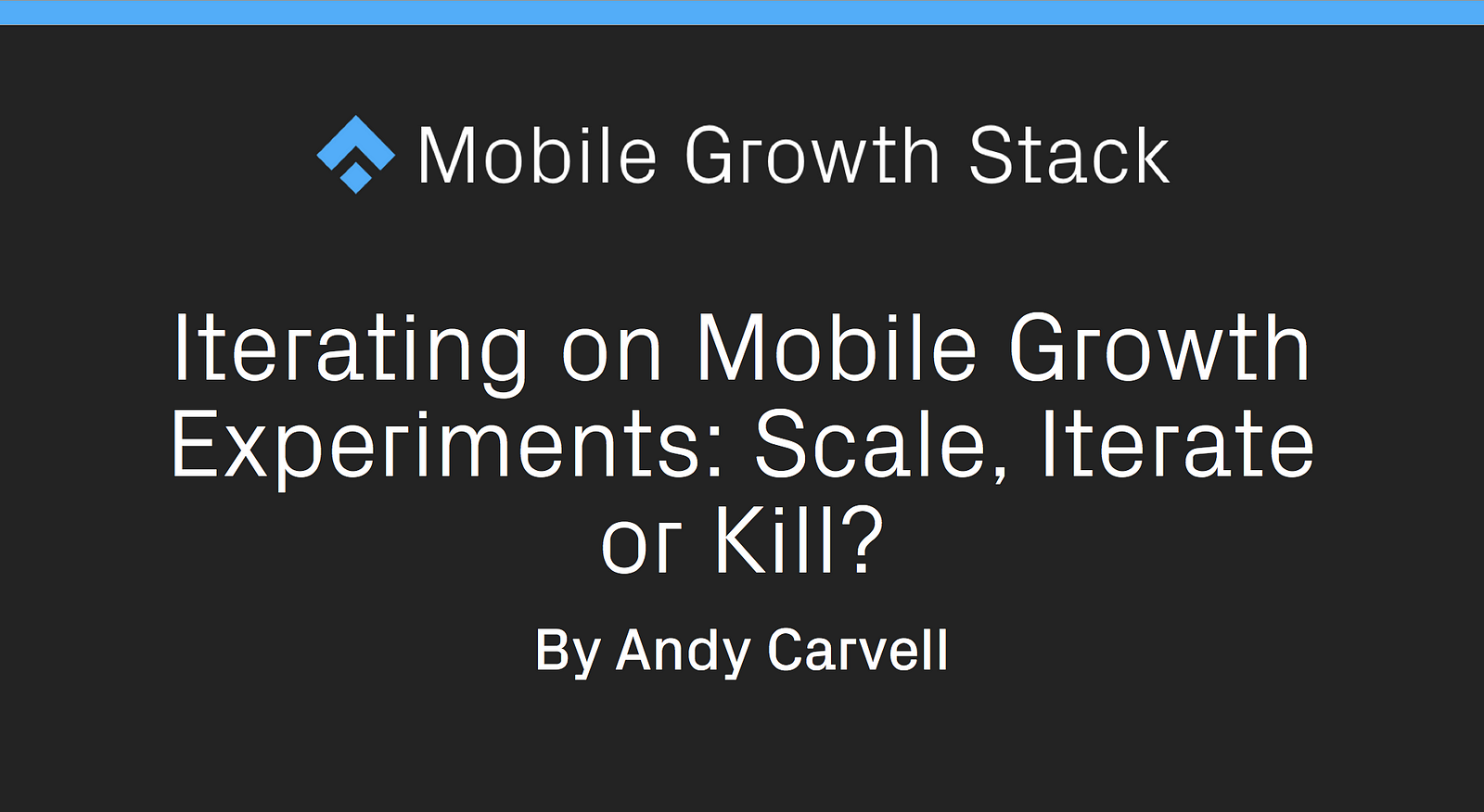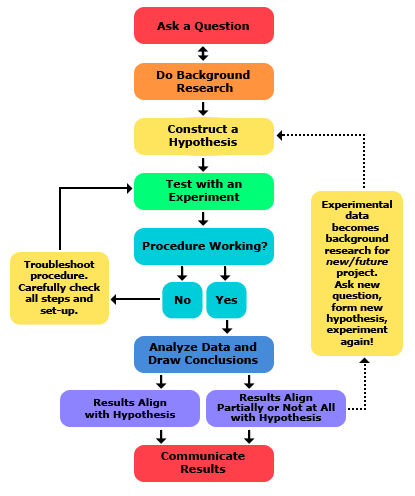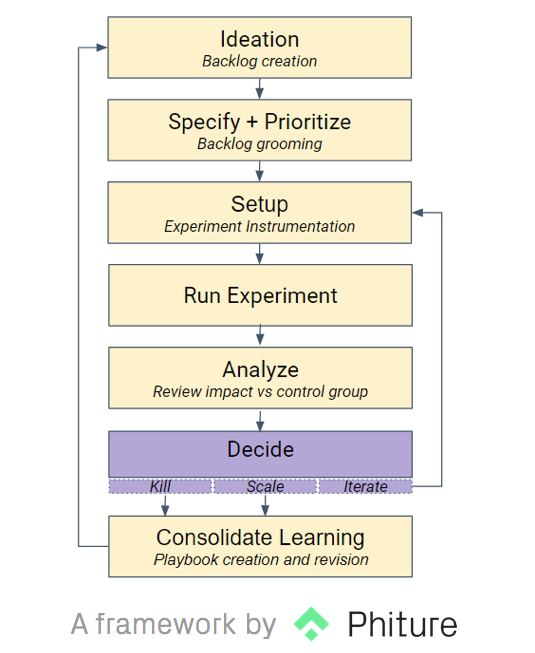Itereren op mobiele groei-experimenten: Schalen, Itereren of Doden?
Iterating on Mobile Growth Experiments: Scale, Iterate or Kill?For growth practitioners, no idea should be too precious to kill
 The most important decision a growth team needs to make on a regular basis is whether to re-invest in or divest resources from the current initiative(s). In my experience, this comes down to one question, which should be answered for each ongoing growth experiment on a weekly basis: Scale, Iterate, or Kill?
The most important decision a growth team needs to make on a regular basis is whether to re-invest in or divest resources from the current initiative(s). In my experience, this comes down to one question, which should be answered for each ongoing growth experiment on a weekly basis: Scale, Iterate, or Kill?Important activities in the growth experiment cycle include: ideation and hypothesis generation, prioritization of new ideas, specifying and instrumenting experiments, analyzing results and communicating them to the broader team.
 The scientific process is quite similar to growth processes (Image: Science Buddies)There’s nothing particularly new or innovative about the growth process: it’s essentially the classic scientific experimental process, applied to digital products (see the diagram on the left by Science Buddies).Successful growth teams around the world are taking a similar approach with their growth experiments.The Scale, Iterate or Kill question comes up at the crucial point in the process that often means the difference between capitalizing on the true potential of a successful experiment on the one hand and failing to capitalize on that impact while simultaneously wasting further sprint cycles iterating on an idea that should be scrapped or shelved.It’s pretty simple, yet most teams routinely stumble at this step:If your experiment succeeded, scale it to your userbase (i.e. turn your experiment result into full impact).If your experiment failed, you should most likely kill the idea dead. It’s either a non-starter, or it might need considerable additional work to re-factor it into a ‘better’ attempt that could still fail.If the results show some positive signs, but not strong or conclusive results, you may want to consider another iteration. You should still balance this against other ideas waiting in the backlog.
The scientific process is quite similar to growth processes (Image: Science Buddies)There’s nothing particularly new or innovative about the growth process: it’s essentially the classic scientific experimental process, applied to digital products (see the diagram on the left by Science Buddies).Successful growth teams around the world are taking a similar approach with their growth experiments.The Scale, Iterate or Kill question comes up at the crucial point in the process that often means the difference between capitalizing on the true potential of a successful experiment on the one hand and failing to capitalize on that impact while simultaneously wasting further sprint cycles iterating on an idea that should be scrapped or shelved.It’s pretty simple, yet most teams routinely stumble at this step:If your experiment succeeded, scale it to your userbase (i.e. turn your experiment result into full impact).If your experiment failed, you should most likely kill the idea dead. It’s either a non-starter, or it might need considerable additional work to re-factor it into a ‘better’ attempt that could still fail.If the results show some positive signs, but not strong or conclusive results, you may want to consider another iteration. You should still balance this against other ideas waiting in the backlog. In a healthy growth team, the majority of experiments should be killed, some should be scaled and a choice few deserve further immediate iteration. Let’s consider these three possible outcomes of the decision process:Kill off failed initiatives (quickly!)In general, the team should err on the side of ‘killing’ unsuccessful experiments.It’s liberating to let go of ideas, cut losses, move on and not get stuck in dead-horse-flogging mode; embrace the reality that many ideas simply aren’t winners.Team dynamics might keep ideas in play when they should be killed. People get attached to bad ideas and ego prevents them from admitting when ideas are not working; they blame the experiment setup, the analysis, or external factors and argue for another iteration. All of those could be valid reasons to stick with the experiment, or they may represent a refusal to accept failure.To build an organizational immunity to becoming attached to bad ideas, it’s helpful for growth teams to deliberately adopt a default pro-kill stance in the Decide step of the experimental process. Requiring a high burden of proof to decide not to kill an idea that fails to demonstrate impact in the first iteration forces team members to build an empirical case for re-investing in a further iteration.No Shame in FailingIn a high-functioning growth team, there is no shame in a failed experiment; the majority of experiments will fail and the team is fine with this, as long as momentum is kept high. There should be shame, however, in repeatedly iterating on a bad idea, at the expense of potentially better ones, in the face of mounting evidence that it’s not going to deliver impact.Killing an idea = stimulus for learningUpon killing an experiment, consider what has been learned. The idea didn’t work, at least in this formulation, but why? This question is a trigger for further research and analysis. This, in turn, might lead to an improved incarnation of the idea at a later stage. Any experiment that leads to deeper understanding of user behavior and psychology should not be considered a waste of time.Celebrate the KillFor the reasons above, high-functioning growth teams celebrate killing experiments and look forward to testing the next idea. The process of acknowledging the ‘kill’, documenting learning and then letting go frees up mental space and allows the team focus on the upcoming experiment, which could be a winner.In our weekly meetings in the growth team I led at SoundCloud, we congratulated the originator of every idea we killed and high-fived to celebrate making progress and keeping momentum. This celebration often occurred more than once per meeting; we killed a lot of stuff that wasn’t working and grew to love doing it. It became part of our ethos to move fast, test things, scale what worked and kill what didn’t. If we felt that someone was too attached to their initiative, we’d them out on it; occasionally this happened to me. It was a safe space to do this and led to the team coalescing around a healthy, ego-less and rational approach to our work.If it works, scale it right away
In a healthy growth team, the majority of experiments should be killed, some should be scaled and a choice few deserve further immediate iteration. Let’s consider these three possible outcomes of the decision process:Kill off failed initiatives (quickly!)In general, the team should err on the side of ‘killing’ unsuccessful experiments.It’s liberating to let go of ideas, cut losses, move on and not get stuck in dead-horse-flogging mode; embrace the reality that many ideas simply aren’t winners.Team dynamics might keep ideas in play when they should be killed. People get attached to bad ideas and ego prevents them from admitting when ideas are not working; they blame the experiment setup, the analysis, or external factors and argue for another iteration. All of those could be valid reasons to stick with the experiment, or they may represent a refusal to accept failure.To build an organizational immunity to becoming attached to bad ideas, it’s helpful for growth teams to deliberately adopt a default pro-kill stance in the Decide step of the experimental process. Requiring a high burden of proof to decide not to kill an idea that fails to demonstrate impact in the first iteration forces team members to build an empirical case for re-investing in a further iteration.No Shame in FailingIn a high-functioning growth team, there is no shame in a failed experiment; the majority of experiments will fail and the team is fine with this, as long as momentum is kept high. There should be shame, however, in repeatedly iterating on a bad idea, at the expense of potentially better ones, in the face of mounting evidence that it’s not going to deliver impact.Killing an idea = stimulus for learningUpon killing an experiment, consider what has been learned. The idea didn’t work, at least in this formulation, but why? This question is a trigger for further research and analysis. This, in turn, might lead to an improved incarnation of the idea at a later stage. Any experiment that leads to deeper understanding of user behavior and psychology should not be considered a waste of time.Celebrate the KillFor the reasons above, high-functioning growth teams celebrate killing experiments and look forward to testing the next idea. The process of acknowledging the ‘kill’, documenting learning and then letting go frees up mental space and allows the team focus on the upcoming experiment, which could be a winner.In our weekly meetings in the growth team I led at SoundCloud, we congratulated the originator of every idea we killed and high-fived to celebrate making progress and keeping momentum. This celebration often occurred more than once per meeting; we killed a lot of stuff that wasn’t working and grew to love doing it. It became part of our ethos to move fast, test things, scale what worked and kill what didn’t. If we felt that someone was too attached to their initiative, we’d them out on it; occasionally this happened to me. It was a safe space to do this and led to the team coalescing around a healthy, ego-less and rational approach to our work.If it works, scale it right awayGetting good at the Decide step should be a key goal for growth teams; it doesn’t matter how good the results are if the impact is not scaled.To quote Jeff Bezos: “To invent you have to experiment, and if you know in advance that it’s going to work, it’s not an experiment.”Following the scale, iterate, kill process rigorously enables growth teams to move faster and increase the number of ideas they can test, which is a key goal of a strong growth setup. Actively celebrating Kills increases momentum and helps to avoid a middle-of-the-road mentality where only mediocre ideas are tested. Scaling wins to production maximises impact as team moves forward.It’s also a lot more fun once you learn to let your killer instinct run free ;)
Source: mobilegrowthstack.com

